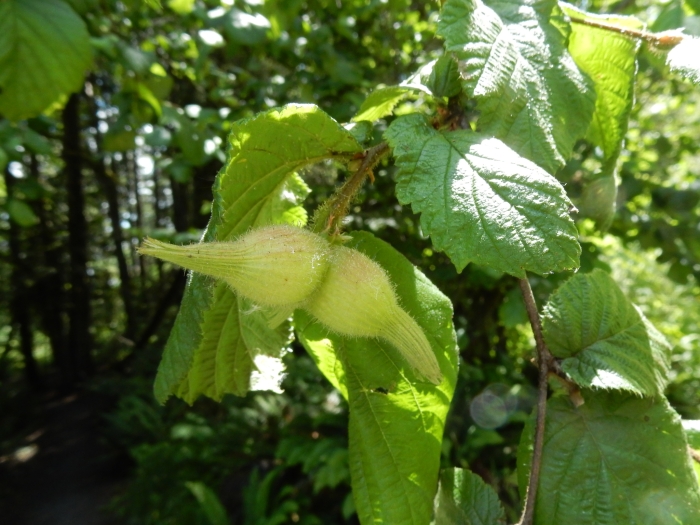California Hazelnut
(Corylus cornuta var. californica)
California Hazelnut (Corylus cornuta var. californica)
/
/

Ed Alverson
CC BY 4.0
Image By:
Ed Alverson
Recorded By:
Copyright:
CC BY 4.0
Copyright Notice:
Photo by: Ed Alverson | License Type: CC BY 4.0 | License URL: http://creativecommons.org/licenses/by/4.0/ | Rights Holder: Ed Alverson | Publisher: iNaturalist | Date Created: 2020-06-27T13:33:54-07:00 |






















































Estimated Native Range
Summary
Corylus cornuta var. californica, commonly known as California Hazelnut, is a deciduous shrub native to the understory of coastal forests and along streambanks in the Pacific Northwest, including Western USA and Canada. It typically grows to a height of 9-12 feet (2.7-3.7 meters) and a width of 6-9 feet (1.8-2.7 meters). This species forms a multi-stemmed clump with a rounded habit. The shrub produces inconspicuous yellow male catkins and small red female flowers in the spring, which are not particularly showy but are interesting upon close inspection. The foliage is bright green, turning to hues of yellow and orange in the fall, adding seasonal interest to the landscape.
California Hazelnut is valued for its wildlife benefits, as it provides food for birds and mammals with its edible nuts, which mature in the fall. It is used in naturalized plantings, as a screen or hedge, and in restoration projects due to its adaptability and ease of maintenance. It thrives in partial shade to full sun, prefers well-drained soils but tolerates a range, and requires moderate water. While generally disease-resistant, it can be susceptible to Eastern Filbert Blight in some regions. Gardeners should be aware of its potential to spread by suckers, which can be managed by periodic thinning.CC BY-SA 4.0
California Hazelnut is valued for its wildlife benefits, as it provides food for birds and mammals with its edible nuts, which mature in the fall. It is used in naturalized plantings, as a screen or hedge, and in restoration projects due to its adaptability and ease of maintenance. It thrives in partial shade to full sun, prefers well-drained soils but tolerates a range, and requires moderate water. While generally disease-resistant, it can be susceptible to Eastern Filbert Blight in some regions. Gardeners should be aware of its potential to spread by suckers, which can be managed by periodic thinning.CC BY-SA 4.0
Plant Description
- Plant Type: Shrub, Tree
- Height: 9-12 feet
- Width: 6-9 feet
- Growth Rate: Slow
- Flower Color: Red, Yellow
- Flowering Season: Spring
- Leaf Retention: Deciduous
Growth Requirements
- Sun: Full Sun, Part Shade
- Water: Medium
- Drainage: Fast, Medium, Slow
Common Uses
Bee Garden, Bird Garden, Butterfly Garden, Deer Resistant, Low Maintenance, Street Planting
Natural Habitat
Understory of coastal forests and along streambanks in the Pacific Northwest
Other Names
Common Names: Pacific Beaked Hazelnut , Western Hazel , Western Hazelnut , Noisetier De Californie , Noisetier À Long Bec De Californie
Scientific Names: Corylus cornuta var. californica , Corylus cornuta subsp. californica , Corylus californica , Corylus rostrata var. californica , Corylus rostrata var. tracyi , Corylus cornuta var. glandulosa , Corylus cornuta f. glandulosa
GBIF Accepted Name: Corylus cornuta subsp. californica (A.DC.) A.E.Murray